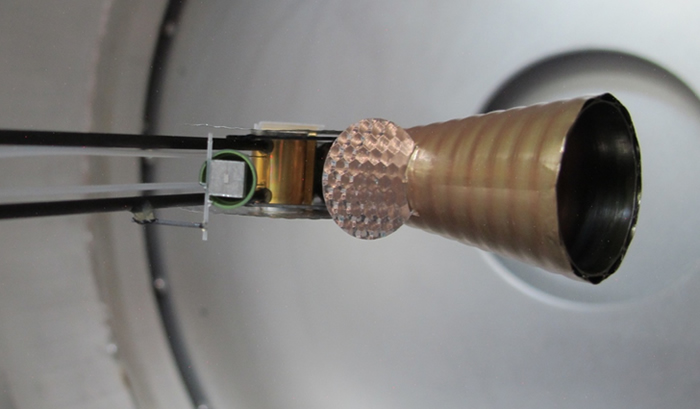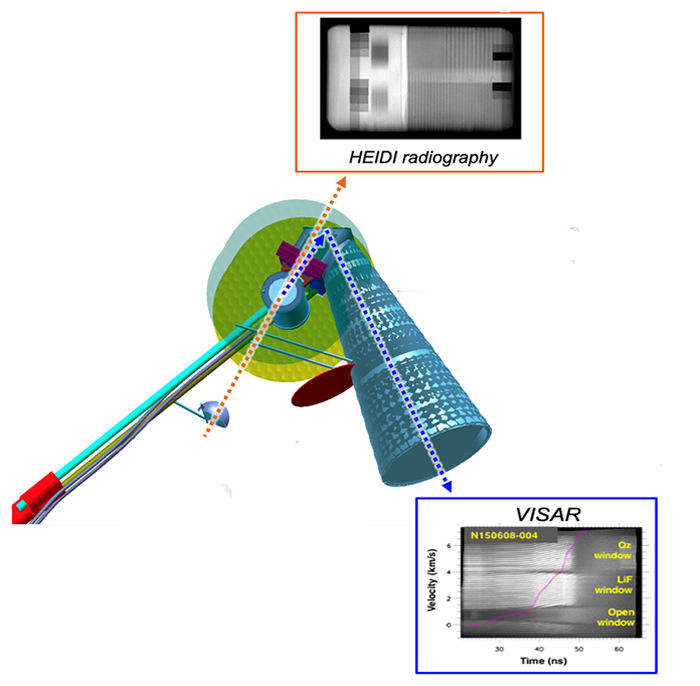Making Two Measurements in One Shot
January 9, 2019
A team of physicists and Target Fabrication designers has devised a “two-for-one” NIF diagnostic platform for measuring the strength of materials under extreme pressure.
The Simultaneous VISAR instrument measures—in one NIF shot instead of two or more shots—both the time history of pressures applied to the target sample by a hohlraum and the growth of Rayleigh-Taylor perturbation radiography during compression. Along with enhancing NIF shot efficiency, the split platform also increases the accuracy of the measurements.
“We’ll be reducing lots of uncertainty of our physics measurements,” said physicist Hye-Sook Park, a NIF group leader and one of the Lab’s Distinguished Members of Technical Staff (DMTS).
 The Simultaneous VISAR diagnostic platform mounted inside the NIF Target Chamber. Credit: Hye-Sook Park
The Simultaneous VISAR diagnostic platform mounted inside the NIF Target Chamber. Credit: Hye-Sook Park Although the basic concept of combining the two measurements “was kind of simple,” she said, building the target and implementing the diagnostic instrument was a very difficult task.
“I wanted to have this capability for many, many years, but I didn’t want to push the target team too much because the whole thing is way too complicated to start with,” she said. “So, I did it step by step.”
Park is an experimental leader of a program for understanding the strengths of materials placed under extreme pressure and strain—measurements that are important for the Lab’s stockpile stewardship mission. Her team and other scientists are using NIF’s high-energy lasers focused on a tiny hohlraum inside the Target Chamber to reproduce the extreme pressures found in the center of planets, stars, and nuclear weapons.
To determine the strength of different materials under those conditions, scientists have used a Velocity Interferometer System for Any Reflector, or VISAR, to measure the pressure of a laser-driven compression, known as the drive shot, along with High Energy Imaging Diagnostic (HEIDI) radiography to measure growth of Rayleigh-Taylor instabilities as the material is compressed.
Varying Conditions
Both sets of data are needed to chart material strength. But measurements taken in separate NIF shots might have different conditions, making comparing the data trickier.
“By having two in one, you’ll be able to do a one-to-one comparison moving forward,” said Target Fabrication Engineer Dawn Lord. “By understanding how much pressure is being applied, they’ll be able to get a more truthful answer about strength.”
Pascale Di Nicola, Target Fabrication deputy production manager, said getting the best data with one shot is especially important when testing certain special materials for strength, “when they want to make sure they have the right information on everything and have to get good data.”
 Diagram showing the paths of the two-for-one measurements made possible by the Simultaneous VISAR.
Diagram showing the paths of the two-for-one measurements made possible by the Simultaneous VISAR. Building the one-shot instrument was also tricky, however, because of the tiny amount of physical space available and different diagnostic needs.
Half the target package is for VISAR measurements and to record tiny Doppler wavelength shifts caused by the movement of the material being compressed by the main laser-induced energy. The other half has a rippled surface used to measure the growth of Rayleigh-Taylor hydrodynamic instabilities in the material as it is compressed.
For VISAR, independent laser beams directed through an adjacent cone reflect off a silicon mirror to the VISAR half of the plate, then reflect back off the mirror and through the cone. The mirror and cone had to be placed at angles that would not interfere with the main radiography. Di Nicola noted the team had to make sure the x rays and plasmas produced for the radiography side did not interfere with readings for the VISAR, which is “very sensitive to plasma backgrounds.”
The effort to build the Simultaneous VISAR took more than a year, Lord said. That included the time it took to make sure the VISAR mirror was cut, angled, and sized correctly, and ensuring the new instrument wouldn’t cause unintended damage to another part of NIF.
Park credited a team effort led by Lord, Di Nicola, Target CAD designers Scott Vonhof and Chris Santos, and scientists Damian Swift and Channing Huntington with designing and testing the precision-made components. The Target and Laser Interaction Sphere Working Group’s Debris and Shrapnel team led by Nathan Masters provided guidance and ran simulations to make sure the design would be safe to use on NIF, and the VISAR Alignment Team demonstrated that VISAR performance could achieve the large offsets required to collect the data.
Target Fabrication machinist Gino Mercado prepared the complex physics package, made of multiple micron-thin layers of different materials prepared by Jack Nguyen and Anthony Decker. It was then attached just outside the hohlraum, fabricated at General Atomics in San Diego, and characterized by GA’s John Vickers.
Data Worries
Originally, the simultaneous VISAR was scheduled for testing in April, but a hohlraum leak postponed that shot until September. Until the shot took place, the team members weren’t entirely sure what data they would get, especially on the VISAR.
“We were really worried that VISAR would completely blank out from the plasma backgrounds from the hohlraum and the x-ray backlighter,” Park said.
To their relief, both sides of the platform performed as expected. The VISAR, however, did record a slight blank in the latter stages of the shot, because of VISAR’s view of the backlighter laser beams.
“This can be fixed for the next shot by having more shielding on the backlighter side,” Park said. “We got the majority of the data.”
She said she was “extremely happy” with the results and plans to slowly switch her experiments to using Simultaneous VISAR, possibly by mid-2019.
“I have to really thank the target team,” Park said. “And Dawn Lord, she is basically the heroine of this whole effort. She came up with all the design of the mounting and the mirrors and went through all the approval processes. This is a huge success.”
—Benny Evangelista
Follow us on Twitter: @lasers_llnl



